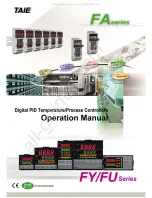
CHAPTER 5: SETTINGS
SYSTEM SETUP
L30 LINE CURRENT DIFFERENTIAL SYSTEM – INSTRUCTION MANUAL
5-137
5
The phase sequence of the power system is required to properly calculate sequence components and power parameters.
The
PHASE ROTATION
setting matches the power system phase sequence and informs the relay of the actual system phase
sequence, either ABC or ACB. CT and VT inputs on the relay, labelled as A, B, and C, must be connected to system phases A,
B, and C for correct operation.
The
FREQUENCY AND PHASE REFERENCE
setting determines which signal source is used (and hence which AC signal) for
phase angle reference. The AC signal used is prioritized based on the AC inputs configured for the signal source. Phase
voltages takes precedence, followed by auxiliary voltage, then phase currents, and finally ground current.
For three phase selection, phase A is used for angle referencing (V
ANGLE REF
= V
A
), while Clarke transformation of the phase
signals is used for frequency metering and tracking (V
FREQUENCY
= (2V
A
- V
B
- V
C
) / 3) for better performance during fault,
open pole, and VT and CT fail conditions.
The phase reference and frequency tracking AC signals are selected based upon the source configuration, regardless of
whether or not a particular signal is actually applied to the relay.
Phase angle of the reference signal always displays zero degrees and all other phase angles are relative to this signal. If the
pre-selected reference signal is not measurable at a given time, the phase angles are not referenced.
The phase angle referencing is done via a phase locked loop, which can synchronize independent UR-series relays if they
have the same AC signal reference. This results in very precise correlation of phase angle indications between different UR-
series relays.
FREQUENCY TRACKING
is set to “Disabled” only in unusual circumstances; consult GE Grid Solutions for special variable-
frequency applications.
5.5.3 Signal sources
SETTINGS
SYSTEM SETUP
SIGNAL SOURCES
SOURCE 1(2)
Identical menus are available for each source. The "SRC 1" text can be replaced by with a user-defined name appropriate
for the associated source.
The first letter in the source identifier represents the module slot position. The number directly following this letter
represents either the first bank of four channels (1, 2, 3, 4) called “1” or the second bank of four channels (5, 6, 7, 8) called
“5” in a particular CT/VT module. See the Introduction to AC Sources section at the beginning of this chapter for details.
The frequency tracking feature functions only when the L30 is in the “Programmed” mode. If the L30 is “Not
Programmed,” then metering values are available but can exhibit significant errors.
Select the nominal system frequency as 50 Hz or 60 Hz only. The
FREQUENCY AND PHASE REFERENCE
setting, used as
a reference for calculating all angles, must be identical for all terminals. Whenever the 87L function is “Enabled,” the
frequency tracking function is disabled, and frequency tracking is driven by the UR algorithm. Whenever the 87L
function is “Disabled,” the frequency tracking mechanism reverts to the UR-series mechanism that uses the
FREQUENCY TRACKING
setting to provide frequency tracking for all other elements and functions.
SOURCE 1
SOURCE 1 NAME:
SRC 1
Range: up to 20 alphanumeric characters
SOURCE 1 PHASE CT:
None
Range: None, F1,... up to any 6 CTs. Only Phase CT
inputs are displayed.
SOURCE 1 GROUND CT:
None
Range: None, F1,... up to any 6 CTs. Only Ground CT
inputs are displayed.
SOURCE 1 PHASE VT:
None
Range: None, F5
Only phase voltage inputs are displayed
SOURCE 1 AUX VT:
None
Range: None, F5
Only auxiliary voltage inputs are displayed
















































